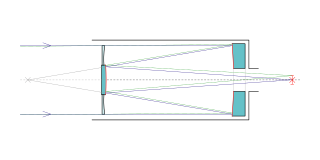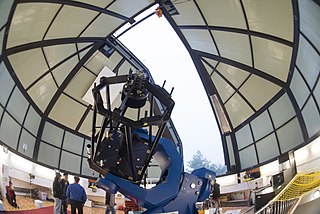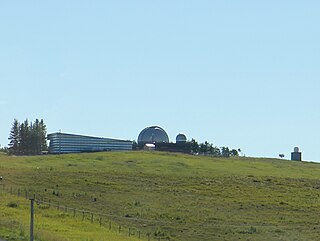
A Ritchey–Chrétien telescope is a specialized variant of the Cassegrain telescope that has a hyperbolic primary mirror and a hyperbolic secondary mirror designed to eliminate off-axis optical errors (coma). The RCT has a wider field of view free of optical errors compared to a more traditional reflecting telescope configuration. Since the mid 20th century, a majority of large professional research telescopes have been Ritchey–Chrétien configurations; some well-known examples are the Hubble Space Telescope, the Keck telescopes and the ESO Very Large Telescope.

Boyden Observatory is an astronomical research observatory and science education centre located in Maselspoort, 20 kilometres (12 mi) north-east of the city of Bloemfontein in Free State, South Africa. The observatory is managed by the Physics Department of the University of the Free State (UFS). The Friends of Boyden assist the observatory as a public support group, organising open evenings and protecting its public interest. Boyden also makes use of members of ASSA Bloemfontein Centre, the amateur astronomy club of the city, for presenters and telescope assistants.

The Schmidt–Cassegrain is a catadioptric telescope that combines a Cassegrain reflector's optical path with a Schmidt corrector plate to make a compact astronomical instrument that uses simple spherical surfaces.

The Guillermo Haro Observatory is an astronomical observatory owned and operated by the National Institute of Astrophysics, Optics and Electronics in the Mexican state of Sonora. It is located 13 km (8.1 mi) north of Cananea and 85 km (53 mi) south-east of Mount Hopkins. It is named after Professor Guillermo Haro.

The Molėtai Astronomical Observatory is an astronomical observatory owned and operated by Vilnius University Institute of Theoretical Physics and Astronomy. It is located on the Kaldiniai Hill next to Kulionys, Lithuania, 10 km from the town of Molėtai.

The Vainu Bappu Observatory is an astronomical observatory owned and operated by the Indian Institute of Astrophysics. It is located at Kavalur in the Javadi Hills, near Vaniyambadi in Tirupattur district in the Indian state of Tamil Nadu. It is 200 km south-west of Chennai and 175 km south-east of Bangalore.

Mount Laguna Observatory (MLO) is an astronomical observatory owned and operated by San Diego State University (SDSU). The telescope was operated in partnership with the University of Illinois at Urbana-Champaign (UIUC) until 2000. MLO is located approximately 75 kilometers (47 mi) east of downtown San Diego, California (USA) on the eastern edge of the Cleveland National Forest in the Laguna Mountains on the SDSU Astronomy Campus near the hamlet of Mount Laguna. MLO was dedicated on June 19, 1968, seven years after SDSU's Department of Astronomy became an independent academic department of SDSU's College of Sciences. The dedication took place during the 1968 summer meeting of the Astronomical Society of the Pacific. Currently SDSU is working with University of Kansas (KU), and UNC Chapel Hill on various projects.

Naylor Observatory is an astronomical observatory owned and operated by Astronomical Society of Harrisburg. It is located near Lewisberry, Pennsylvania, United States.
The Hamilton Astronomical Society Observatory is located next to the Hamilton Zoo in Brymer Road to the west of Hamilton City, New Zealand. The Hamilton Astronomical Society was founded in 1933 and is one of New Zealand's oldest astronomical societies.

The Hirsch Observatory is an astronomical observatory at Rensselaer Polytechnic Institute (RPI) in Troy, New York. It is located on the roof of the Jonsson-Rowland Science Center and is used by members of the Rensselaer Astrophysical Society as well as astronomy students in laboratory exercises. It is frequently opened to the community for public viewing sessions. The observatory's main dome contains a 16" Cassegrain Reflector, with a CCD camera and fully computerized controls. The observatory also owns a variety of smaller scopes and a SBIG Spectrograph. The spectrograph has been used to catalog bright solar spectrum as part of an effort to create an online digital database for astrophysical research. The current director of the observatory is Professor Heidi Newberg.

Shamakhy Astrophysical Observatory is an observatory in the Caucasus Mountains in Azerbaijan. It is named after Nasreddin Tusi (Shao). It is located on the eastern slope of Pirqulu, at an elevation of 1500 m. It has 150–200 clear, cloudless nights per year.

The Oliver Observing Station is an independent professional astronomical observatory named after Barnard M. Oliver. It is owned and operated by The Monterey Institute for Research in Astronomy (MIRA).

The Heights Observatory is an Astronomical Observatory at The Heights School in Modbury Heights, Adelaide, South Australia.

The Lulin Observatory is an astronomical observatory operated by the Institute of Astronomy, National Central University in Taiwan.
The Whakatane Astronomical Society is a voluntary, non-profit society for people interested in amateur astronomy in the Whakatane District of New Zealand. The society was founded in September 1960, and maintains a small observatory in Whakatane, which has been operating continuously since 1964. The society is affiliated with the Royal Astronomical Society of New Zealand.

The Meade LX200 is a family of commercial telescopes produced by Meade Instruments launched in 1992 with 8" (20.32 cm) and a 10" (25.4 cm) Schmidt–Cassegrain models on computerized altazimuth mounts. Two larger models, a 12" (30.48 cm) and a 16" (40.64 cm), quickly followed. The original version was later informally named the "classic" LX200 as newer upgraded versions replaced it. The first of these was the LX200GPS, which featured global positioning system electronics. A 360 mm (14 in) LX200GPS was later added to the line.

Corralitos Observatory was an astronomical observatory located in the Rough and Ready Hills approximately 30 kilometers (19 mi) west of Las Cruces, New Mexico. It was formally dedicated on October 12, 1965, serving as a remote station of Dearborn Observatory, Northwestern University. In October 1965, a NASA program to detect transient lunar phenomenon (TLP) was begun by the staff. Using two-person observer teams, a total of 6,466 man-hours of lunar observation was recorded. The program was run until 1972 but did not confirm any TLP. Using ninety-eight selected reports of TLPs received from amateurs during this period, 39 were checked from Corralitos Observatory.

The Wyoming Infrared Observatory (WIRO) is an astronomical observatory owned and operated by the University of Wyoming. It is located 40 kilometers (25 mi) southwest of Laramie, Wyoming (USA) on Jelm Mountain. It was founded in 1975, and observations began at the site in 1977. Recent research performed at WIRO includes searching for runaway stars, monitoring short-term variations in blazars, and monitoring massive binary stars.

The Rothney Astrophysical Observatory (RAO) is an astronomical observatory located near the hamlet of Priddis, Alberta, Canada, about 25 kilometres (16 mi) southwest of Calgary. The observatory is owned and operated by the University of Calgary (UC), and was dedicated in 1972. The facility is used for research, undergraduate and graduate teaching, and public outreach. Research performed at the RAO included a variable star search program, follow-up observations of variable star discoveries, and detailed investigation of binary stars. An outstanding minor planet search program was also performed with comet discoveries by Rob Cardinal. The RAO now participates in many follow-up observation programs, including the Quark Nova project.

Tortugas Mountain Observatory (TMO) is an astronomical observatory owned and operated by New Mexico State University (NMSU). It is located on Tortugas Mountain, also known locally as 'A' Mountain, in southern New Mexico (USA), approximately 8 kilometers (5.0 mi) southeast of Las Cruces and 4 kilometers (2.5 mi) east of the NMSU campus. Founded in 1963 under the supervision of Clyde Tombaugh, the observatory focused on observing the planets. Much of the information captured at TMO is now available through the Planetary Data System's Atmospheres Node, which is managed by NMSU. The two-dome observatory building was completed in 1964, though observing began with one of the telescopes in 1963. A second building, with a larger single dome, was completed at the opposite end of the ridgeline of Tortugas Mountain in 1967. Regular use of TMO ceased in 1999 or 2000, but the observatory equipment was not dismantled. In 2008 it was used for the Lunar CRater Observing and Sensing Satellite project. In 2010, efforts to revive the observatory for use by the American Association of Variable Star Observers began. As of 10 June 2011, work on project was reported to be 60-75% done.















